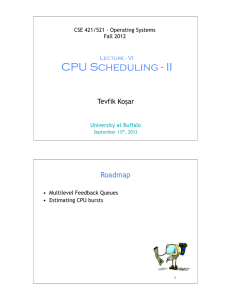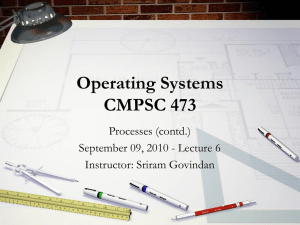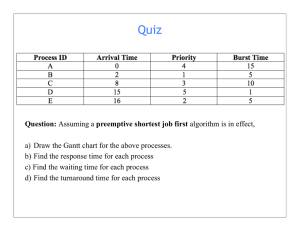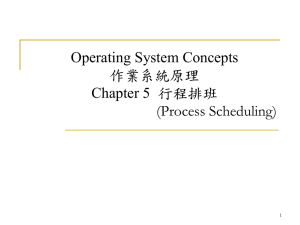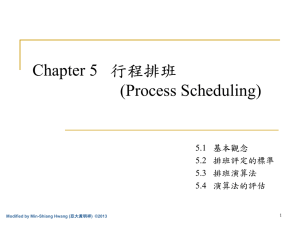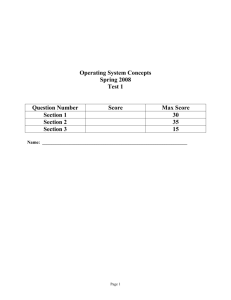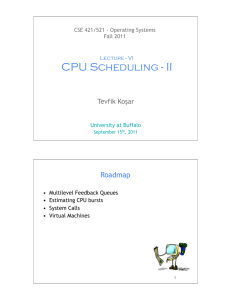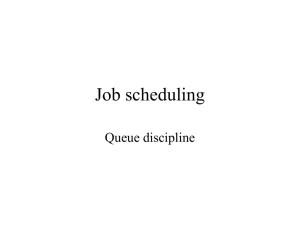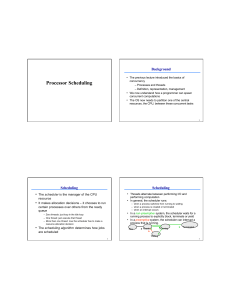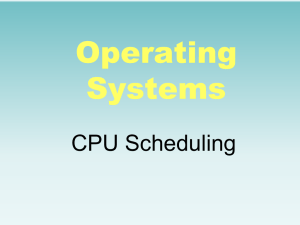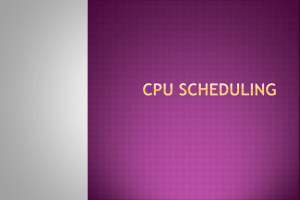May 16 - Process Scheduling part 2
advertisement
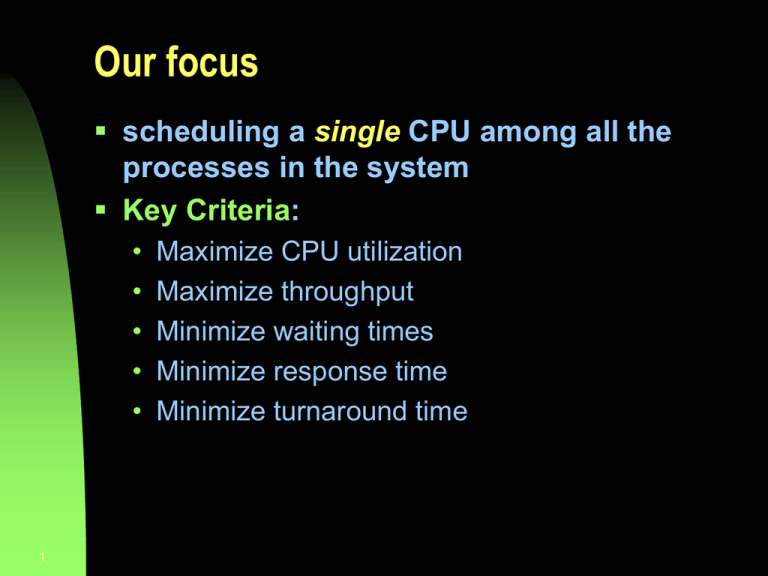
Our focus scheduling a single CPU among all the processes in the system Key Criteria: • • • • • 1 Maximize CPU utilization Maximize throughput Minimize waiting times Minimize response time Minimize turnaround time Two Components of Scheduling Policies Selection function which process in the ready queue is selected next for execution? Decision mode at what times is the selection function exercised? • Nonpreemptive A process in the running state runs until it blocks or ends • Preemptive Currently running process may be interrupted and moved to the Ready state by the OS Prevents any one process from monopolizing the CPU 2 A running example to discuss various scheduling policies Arrival Time Burst Time 1 0 3 2 2 6 3 4 4 4 6 5 5 8 2 Process 3 First Come First Served (FCFS) Selection function: the process that has been waiting the longest in the ready queue (hence, FCFS, FIFO queue) Decision mode: nonpreemptive • a process runs until it blocks itself (I/O or other) Drawbacks: favours CPU-bound processes 4 Shortest Job First (SJF) Shortest job First (SJF) Selection function: the process with the shortest expected CPU burst time Decision mode: non-preemptive I/O bound processes will be picked first Estimate the expected CPU burst time for each process: on the basis of past behavior. Drawback: Longer processes can starve if steady supply of I/O bound jobs 5 Shortest Remaining Time (SRT) = Preemptive SJF If a process arrives in the Ready queue with estimated CPU burst less than remaining time of the currently running process, preempt. Prevents long jobs from dominating. • But must keep track of remaining burst times Better turnaround time than SJF • Short jobs get immediate preference P1 P2 P3 0..3 3..4 4..8 6 P5 8..10 P2 10..15 P4 15..20 Round-Robin Selection function: same as FCFS Decision mode: Preemptive • Maximum time slice enforced by timer interrupt • Running process is put at tail of ready queue 7 Time Quantum for Round Robin 8 must be substantially larger than process switch time should be larger than the typical CPU burst If too large, degenerates to FCFS Too small, excessive context switches (overhead) Round Robin: Critique Still favors CPU-bound processes • An I/O bound process uses the CPU for a time less than the time quantum and then is blocked waiting for I/O • A CPU-bound process runs for its whole time slice and goes back into the ready queue (in front of the blocked processes) One solution: virtual round robin (VRR, not in book…) • When a I/O has completed, the blocked process is moved to an auxiliary queue which gets preference over the main ready queue • A process dispatched from the auxiliary queue gets a shorter time quantum (what is “left over” from its quantum when it was last selected from the ready queue) 9 Priority Queues Scheduler chooses from low priority queue only if higher ones are empty Hi priority Low priority 10 Multilevel Feedback Queues Several READY queues with decreasing priorities: • P(RQ0) > P(RQ1) > ... > P(RQn) • But lower priority queues get longer time slice New processes are placed in RQ0 If they use their time quantum, they are placed in RQ1. If they time out again, they go to RQ2, etc. until they reach lowest priority Automatically reduces priority of CPU-bound jobs, leaving I/O-bound ones at top priority Dispatcher always chooses a process from highest non-empty queue Problem: long jobs can “starve” • Solution: “aging” (promote priority of a process that waits too long in a lower priority queue) 11 Multilevel Feedback Queues RR, Q=1 RR, Q=2 ... Q=4 etc. FCFS Note: many variations of policies possible • including different policies at different levels.. 12 Multilevel Feedback Scheduling Multilevel feedback scheduling is the most flexible method can customize: • • • • • 13 Number of queues Scheduling algorithm per queue Priority “upgrade” criteria Priority “demotion” criteria Policy to determine which queue a process starts in Algorithm Comparison Which one is best? It depends: • on the system workload (extremely variable) • hardware support for the dispatcher • relative weighting of performance criteria (response time, CPU utilization, throughput...) • The evaluation method used • Management priorities machine efficiency vs. user service.. 14 Let’s do some examples.. Work out schedules for: • FCFS • RR(Q=1) • RR(Q=4) Proc 1 • SJF Arrival 0 • SRT Service 10 Compute: • Tr (response time) • Tw(wait time) For each process, and Average for all 5 15 2 2 1 3 4 3 4 5 5 6 1 5 Some Useful Relationships Ta : Arrival Time Ts : Service Time (CPU burst) Tf : Finish time Tw : Wait time Tr = Tf - Ta (response time) Note that: Tf = Ta + Ts + Tw , or T f - T a = T s + Tw = Tr Therefore: Tw = Tr - Ts We start by working out the finish time 16 Example to evaluate various scheduling policies Process 17 Arrival Time Burst Time 1 0 10 2 2 1 3 4 3 4 5 1 5 6 5 Summary Results Proc 1 2 3 4 5 Ta 0 2 4 5 6 1 3 1 5 Ts 10 Average FCFS Tf 10 Tr 10 Tw RR(Q=1) RR(Q=4) 18 8 20 3 Tr 20 1 Tw 10 Tf Tr 14 15 20 10 10 14 7 9 18 7 2 12 0 4 1 19 5 8 19 3 4 8 2 1 7 9 10 Tr 10 0 11 9 11 9 7 Tf Tw SRT 9 Tf Tw SJF 0 11 15 11 13 12 7 8 8 6 7 10.6 6.6 8.4 4.4 20 14 9 9.6 5.6 20 14 9 10.2 6.2 Tf 20 3 8 6 13 Tr 20 1 4 1 7 6.6 Tw 10 0 1 0 2 2.6
